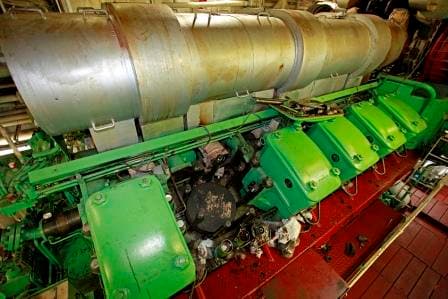We left Huatalco after our evening call and then followed roughly the Mexican coast on a North Westerly course. It will take us two sea days to get to Casa San Lucas which will be our final stop before the cruise ends in San Diego. The weather is remaining great and today we had a NW breeze of about 16 knots blowing and that brought cooler air to the area and good visibility. The moment the wind dies away in this area the warmth creates hazy conditions which limits visibility to about 6 to 8 miles. Now with this “cold” wind blowing we could see more than 15 miles from bridge level. On occasion the mountain ranges of Mexico where clearly visible. Tonight this wind will die down so tomorrow morning we will have a hazy day again. The temperature, even with the cooler wind, peaked today at 89oF but as we are coming closer to the cold currents it will gradually get less. Tomorrow it is forecast to drop already to 80oF in open water and by the time we reach San Diego it will be down to the low seventies.
With a sea day come the regular activities and as we are nearing the end of the cruise, that includes some social happenings such as the Mariners Medal awards. Due to the high number of mariners on board, we are close to a 1000 again this cruise, so we had to split it out into a party for those with medals and then two luncheons to be able to accommodate everybody. I had the honor to award four 700 day medals today, which is no mean feat if you break that down in the average number of cruises that you have to make to get there. 7 world cruises or 50 transcanal cruises or 100 seven day cruises. Something to respect, honor and celebrate and thus we had our party & ceremony this morning. The luncheons will be held during the coming sea days.
As my presence is hardly required on the bridge during a quiet sea day; the navigators know where they are going and what to do, I only show my face 3 or 4 times a day for a quick check. That gives me a lot of spare time for inspections. Some captains favor very formal inspections, marching through the ship with a whole gaggle of other officers in tow but I prefer the more informal way. It means that that whole gaggle of officers are not losing valuable time, time that could be better spent on other issues than just listening to the Master pointing out the obvious. So I prefer to go around myself or with the person directly responsible for an area. That gives much more insight into “the why” of something than just into the fact “of is”. If you find out the why of a situation you can take corrective action to prevent it happening again, if you observe the problem and do not have it corrected, it will re-occur.
Today I went through the engine room and although I am not that technical and do not have half the details about how most of the machinery works, I can still contribute to improvements by questioning why certain things are as they look to me. As is with any profession, sometimes you do not see the forest for the trees and in my case I do see the engine forest but I do not always recognize the machinery – trees.
Still safe working, cleanliness, priorities in work, those are area’s that I can be of assistance. It can be of great use sometimes if the captain helps a bit with pushing certain issues to help the Chief Engineer along with his work. For an older engine room with its myriad of challenges ours is in great shape, and the chief keeps a lot of pressure on his team to keep it that way.
Constant repairs and maintenance are going on and with this cruise where sea and port days are in balance and alternating nicely, the chief has the best of both worlds with maintenance times and testing in the follow up.
All together that brought my day to its 10 hours. We have a company ruling that we should try to stick to that. It is an easy way to then comply with a legal ruling of no more than 13 hours a day and sufficient rest periods in between. There are days, such as the Panama Canal, that I am way over and that means that I have to compensate on other days.
Tomorrow will be another day at sea, with warm temperatures, wind still and hazy weather.
The cylinder head of one of the 5 main engines has been removed showing the top of the cylinder inside the cylinder lining. Photo by HM van Mackelenberg.


Leave a Reply